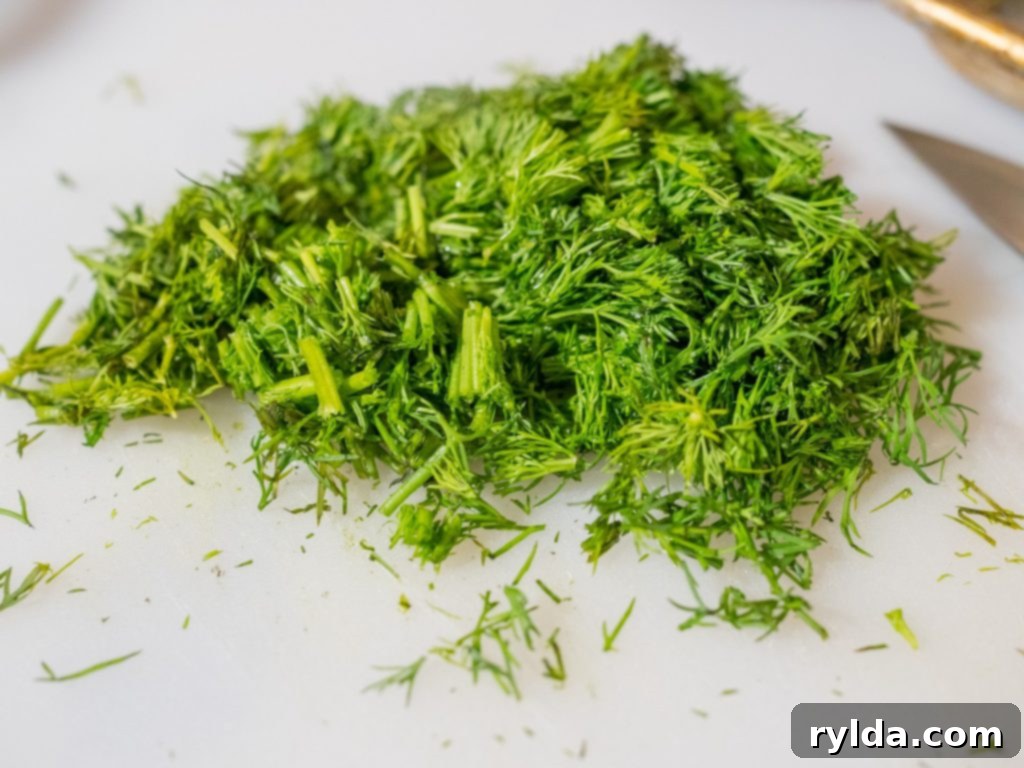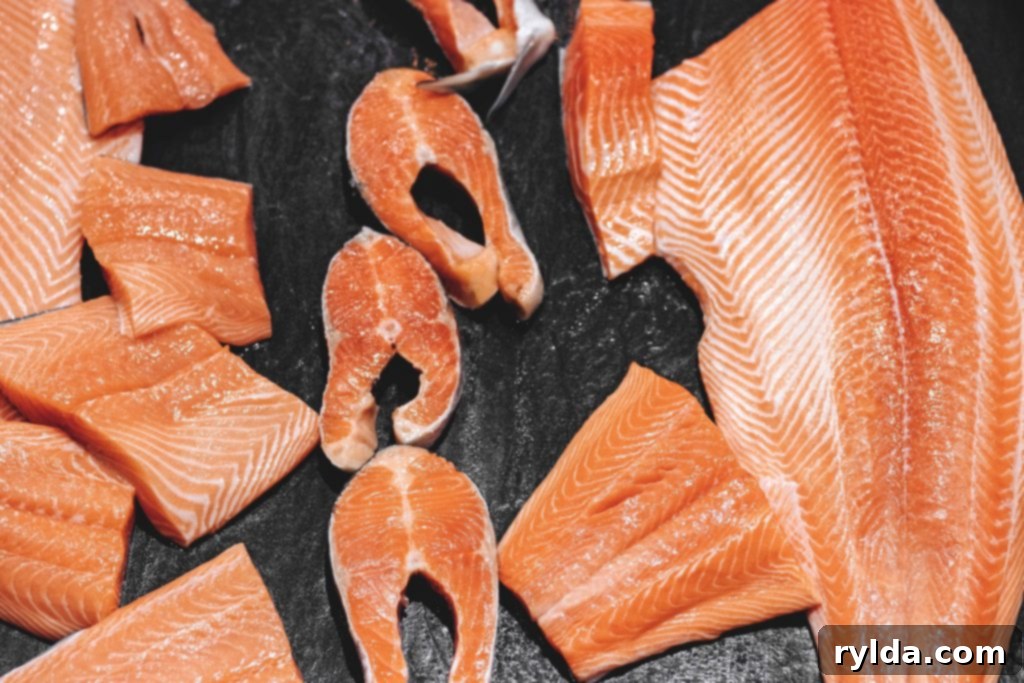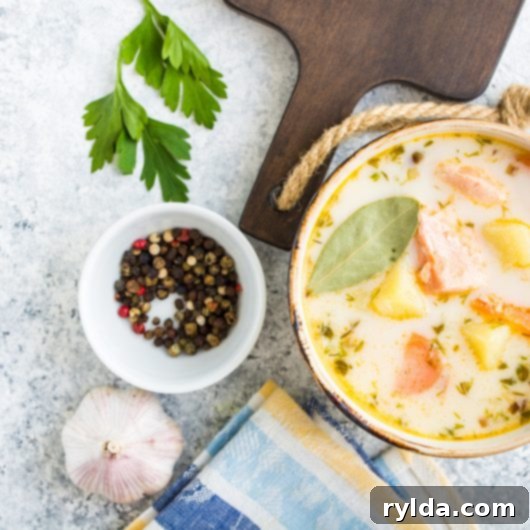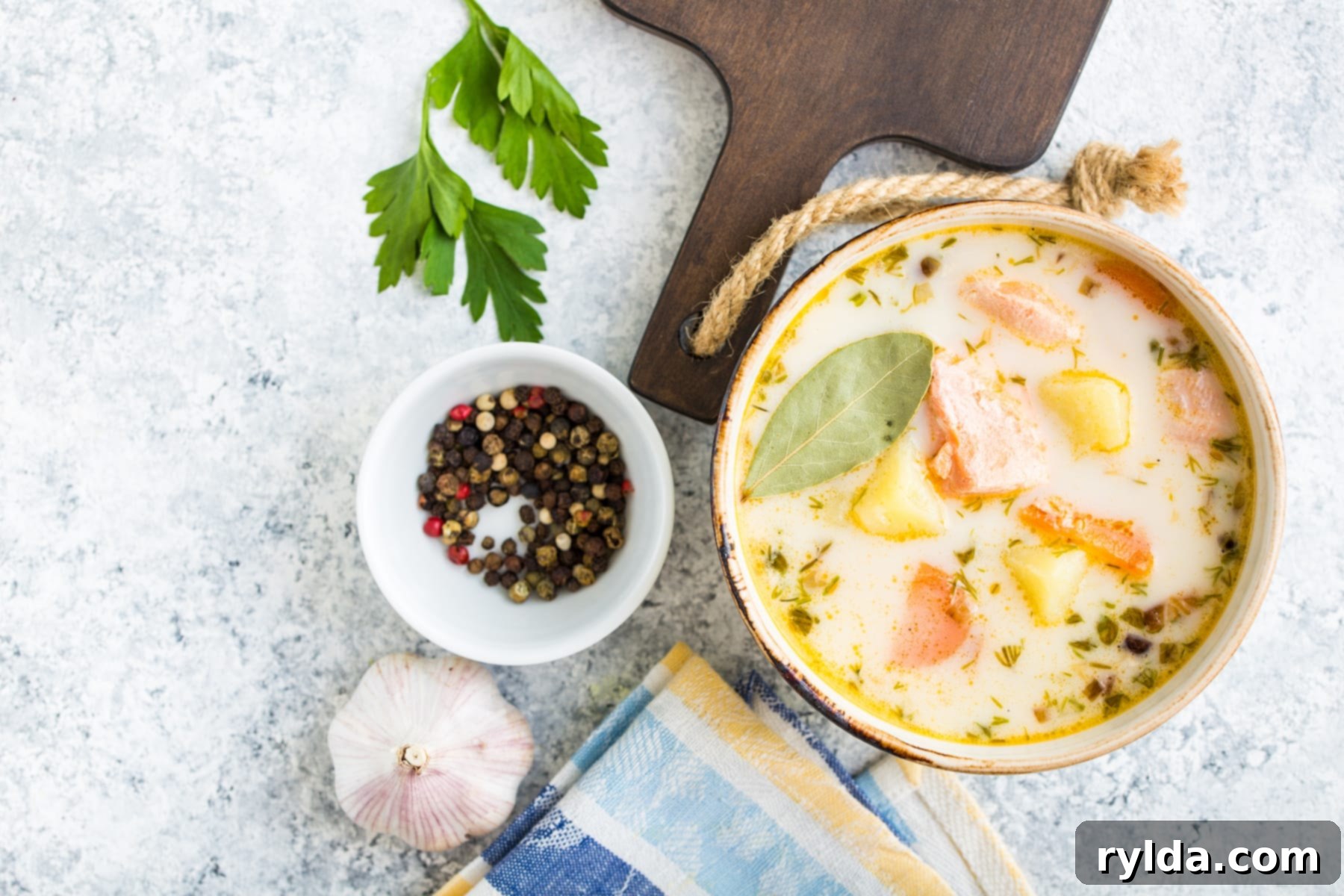The Ultimate Creamy Salmon Chowder: An Easy & Hearty Recipe for Leftovers
There’s nothing quite like a warm, comforting bowl of chowder on a chilly evening, and this Salmon Chowder recipe is truly something special. It’s not just a meal; it’s a cozy embrace, perfect for bringing the family together around the dinner table. What makes this recipe even more brilliant is its versatility: it’s an absolutely fantastic way to transform leftover salmon into a completely new, incredibly satisfying dish. In fact, I often find myself intentionally cooking extra salmon during dinner just so I can whip up this delightful chowder the very next night!
At first glance, the ingredient list might appear a bit extensive, which can sometimes make a recipe seem daunting. However, I assure you, the process itself is wonderfully simple and straightforward. It’s all about layering flavors and letting them meld into a rich, creamy symphony. You start by quickly preparing a few vegetables in a food processor – a real time-saver – then sautéing them gently. While those aromatics develop their flavor, you can easily chop your leftover salmon and dice the potatoes. From there, it’s a simple matter of adding ingredients to the pot, one by one, watching as they transform into a thick, luxurious chowder that every member of the family will eagerly dig into.
The Irresistible Aroma and Flavor of Fresh Herbs
When it comes to elevating the taste and aroma of this Salmon Chowder, fresh parsley and dill are truly non-negotiable in my kitchen. Their vibrant, green freshness and distinct aromatic notes bring an unparalleled brightness to the rich, creamy base of the chowder. The impact of these herbs is especially noticeable when they are sprinkled generously as a garnish over each steaming bowl just before serving. That final touch not only adds a beautiful pop of color but also releases a burst of fresh flavor that, to me, is simply unbeatable. While it might seem like a small detail or an extra expense, I firmly believe that the depth of flavor and incredible aroma they contribute make the investment in fresh herbs entirely worthwhile.

I understand, however, that fresh dill can sometimes be a bit elusive, depending on the season or your local grocery store’s stock. If you find yourself in a pinch and can’t get your hands on fresh herbs, I’ve included helpful notes in the recipe card outlining how to best substitute dry herbs. It’s important to remember that dried herbs have a much more concentrated flavor and a different texture than their fresh counterparts. If you opt for dried herbs, I generally advise against using them as a fresh garnish. Dried herbs need time to rehydrate and cook within the chowder to properly release their flavor, and their texture isn’t quite as appealing when served raw.
However, there’s an excellent middle-ground alternative: freeze-dried dill. I’ve personally experimented with the freeze-dried variety, and I’ve found that it performs exceptionally well in this particular chowder. It retains much of the vibrant flavor and aroma of fresh dill, making it the best possible replacement if fresh is simply unavailable. So, if your culinary adventure for fresh dill comes up short, reach for the freeze-dried option; you won’t be disappointed!
The Heart of the Dish: Essential Ingredients for a Rich Chowder
Selecting Your Salmon: Fresh, Frozen, or Canned?

While fresh salmon is a regular staple in my kitchen, I recognize that not everyone cooks it as frequently as I do. This chowder is incredibly forgiving and adaptable when it comes to the star ingredient. If you’re more comfortable using canned salmon, rest assured it makes a perfectly workable substitute. The taste profile will, naturally, be somewhat different, and the pieces from a can are typically much smaller than bite-sized, but the overall chowder will still be delicious and hearty. If you go this route, I highly recommend sourcing a good quality canned salmon to ensure the best flavor. For those who prefer fresh, I consistently opt for Pacific varieties. My top choices are usually King (often known as Chinook in my region) or Coho salmon, both of which offer a rich flavor and flaky texture. Sockeye is another excellent choice, known for its vibrant color and firm flesh.
Don’t hesitate to consult the fishmonger at your favorite grocery store; they are an invaluable resource and can guide you toward the best selection for your chowder. And remember, frozen fillets are also a fantastic and convenient option that often yield excellent results when thawed properly.
Building the Flavor Foundation: Aromatics and Liquids
The delicious complexity of this chowder begins with a classic aromatic base of shallots, carrots, celery, and garlic. These humble vegetables, when finely minced and gently sweated, create the savory backbone of the dish. The food processor makes quick work of this task, ensuring an even chop and saving you precious prep time. Just be sure to scrape down the sides occasionally for consistent texture. This mirepoix is then cooked until tender and lightly golden, releasing its sweet and earthy notes into the oil.
The liquid components — chicken stock, whole milk, and heavy cream — are crucial for achieving that characteristic creamy texture and depth of flavor. While chicken stock provides a savory foundation, you can easily substitute it with fish or vegetable stock for a different nuance. The combination of whole milk and heavy cream contributes to the chowder’s luxurious mouthfeel. However, if you need to adjust for dietary preferences or what you have on hand, lighter milk options (skim, 1%, 2%, or evaporated milk) can replace whole milk. A note of caution: I do not recommend substituting heavy cream with half-and-half, as it can cause the chowder to ‘break’ or curdle due to its lower fat content. If you need a lighter option, adding an extra 1/2 cup of your chosen milk is a better alternative to heavy cream.
The Hearty Fillers: Potatoes and Wine
Red potatoes are called for in this recipe, offering a firm texture that holds up well during simmering without becoming mushy. If red potatoes aren’t available, Yukon Gold or other white potatoes are suitable alternatives, but keep an eye on them as they tend to crumble more easily when overcooked. Russet potatoes, with their starchy nature, are generally not recommended for chowders as they can break down excessively and make the soup too thick and grainy. The addition of dry white wine for deglazing is a subtle but powerful step, adding a touch of acidity and complexity that brightens the entire dish. If you prefer to omit alcohol, two teaspoons of white wine vinegar can be used as a worthy substitute, providing a similar lift to the flavors.
The Delicious Journey: Crafting Your Salmon Chowder
Ready to create this incredible Salmon Chowder? Here’s the detailed recipe to guide you through each step. This section, including the ingredients, directions, and notes, is designed to be your complete cooking companion.

Salmon Chowder
3.8 from 51 votes
6
servings
20
minutes
45
minutes
Ingredients
-
1 lb 1 Salmon, cooked, divided
-
1/2 lb 1/2 Red potatoes, peeled and diced
-
3 cups 3 Chicken stock
-
1 cup 1 Milk, whole
-
1/2 cup 1/2 Heavy cream
-
1/4 cup 1/4 Dry white wine
-
1 1 Shallot
-
1/2 1/2 Carrot
-
1 1 Celery stalk
-
1 clove 1 Garlic
-
1 1 Lemon, cut in wedges for garnish
-
1/4 cup 1/4 Parsley, fresh, minced, divided
-
1/4 cup 1/4 Dill, fresh, minced, divided
-
3 tablespoons 3 Vegetable or canola oil
-
1 1 Bay leaf
-
2 teaspoons 2 Salt
-
Black pepper, fresh ground to taste
Directions
- Roughly chop celery stalk and 1/2 carrot into 4-5 pieces. Peel and quarter shallot and garlic clove.
- Place celery, carrot, shallot, and garlic clove in food processor. Pulse until all vegetables are finely minced, scraping down sides occasionally if needed for even chopping.
- Heat oil in large pot or stockpot over medium-low to medium heat. Once heated, add vegetables from food processor. Vegetables should sweat and not color more than light golden brown; if they are darkening too much, lower heat. Cook about 6-8 minutes, stirring occasionally.
- While vegetables cook, roughly chop cooked salmon to bite sized pieces, removing any remaining bones. Reserve about 1/4 cup of cooked salmon and chop very fine.
- Once vegetables have cooked to just golden brown, add the 1/4 finely chopped salmon to the vegetables in the pot. Cook 2-3 minutes, stirring occasionally.
- Raise heat to medium or medium-high and deglaze pan with dry white wine, stirring to bring up and cooked bits at the bottom of the pan. Add 3 tablespoons parsley, 3 tablespoons dill, bay leaf, salt, and black pepper to taste. Cook and stir for 1 minute.
- Add chicken stock, milk, and heavy cream to pot. Stir and bring up to low boil — raise heat if necessary.
- Add potatoes. Reduce heat until chowder stays at low bubbling simmer. Simmer 12 minutes, stirring occasionally.
- Add salmon to pot and cook 4-6 minutes, or until potatoes are cooked and salmon is heated through. Remove bay leaf and discard.
- Taste chowder for seasoning and add salt and pepper if needed. Serve with garnish of remaining 1 tablespoon parsley, 1 tablespoon dill, and lemon wedges for guests to squeeze fresh lemon to their taste.
Notes
- Fish or vegetable stock may be used as substitute for chicken stock.
- Skim, 1%, or 2%, or evaporated milk may be used as substitute for whole milk.
- Half and half should not be used as substitute for heavy cream as chowder may break. Suggest adding extra 1/2 cup of milk as substitute for heavy cream if necessary.
- Dry dill or parsley may be used as substitute for fresh. Suggest using 1 1/2 tablespoon of each dry and omitting herbs as garnish.
- White, yellow, leeks, green onions, or red onions may be used as substitute for shallot. Taste will alter.
- Garlic may be omitted.
- Yukon gold or white potatoes may be used as substitute for red. Watch that they don’t overcook as they may crumble more easily. Russet potatoes are not recommended.
- 2 Teaspoons white wine vinegar may be used as substitute for dry white wine.
- Canned salmon may be used in place of cooked fresh salmon.
Expert Tips for Making the Best Salmon Chowder
- **Finely Mince Your Aromatics:** Whether using a food processor or chopping by hand, ensuring your celery, carrots, shallots, and garlic are finely minced allows them to break down and release their flavors evenly into the chowder base. This creates a smooth, integrated flavor without large, chunky pieces.
- **Sweat, Don’t Brown:** When cooking the vegetables, the goal is to “sweat” them – soften them without adding much color. This gentle cooking process draws out their natural sweetness and aromatic compounds, building a delicate and flavorful foundation for the chowder. If they start to brown too quickly, reduce the heat immediately.
- **Don’t Skip Deglazing:** The dry white wine step is more than just adding liquid. Deglazing helps scrape up any delicious browned bits stuck to the bottom of your pot, incorporating those concentrated flavors back into the chowder. This technique adds depth and complexity that you’d otherwise miss.
- **Add Salmon Towards the End:** Since you’re likely using pre-cooked salmon (especially if it’s leftover), it only needs to be heated through. Adding it too early can result in dry, overcooked fish. The last few minutes of simmering are perfect for it to warm up gently and absorb the chowder’s flavors.
- **Taste and Adjust Seasoning:** Chowders, like many soups, benefit greatly from tasting and adjusting the seasoning before serving. Salt levels can vary depending on your stock and personal preference, so always give it a taste test at the end and add more salt and freshly ground black pepper as needed.
Serving Suggestions for a Complete Meal
This creamy Salmon Chowder is hearty enough to be a meal in itself, but it pairs wonderfully with a few simple accompaniments. A crusty loaf of bread or warm dinner rolls are perfect for soaking up every last drop of the rich broth. A light, crisp green salad with a vinaigrette dressing can offer a refreshing contrast to the richness of the chowder. For an extra touch of flavor and texture, consider serving it with a sprinkle of extra fresh dill and parsley, a dash of paprika, or even a few oyster crackers on the side. Don’t forget those lemon wedges – a squeeze of fresh lemon juice brightens the flavor and adds a delightful zest to each spoonful.
Storing and Reheating Your Chowder
Leftover Salmon Chowder is just as delicious the next day! Store any cooled leftovers in an airtight container in the refrigerator for up to 3-4 days. To reheat, gently warm it on the stovetop over medium-low heat, stirring occasionally, until heated through. You might find it has thickened a bit in the fridge; if so, you can add a splash of milk or stock to reach your desired consistency. Avoid boiling vigorously during reheating to prevent the dairy from separating. This chowder does not freeze particularly well due to the dairy and potatoes, which can become grainy or mushy upon thawing, so it’s best enjoyed fresh or from the refrigerator within a few days.
Customizing Your Chowder: Delicious Variations
While this recipe is fantastic as written, it’s also a great canvas for culinary creativity. Feel free to explore these variations to make it your own:
- **Add More Veggies:** Stir in frozen corn, peas, or diced bell peppers along with the potatoes for added color, texture, and nutrients. A handful of fresh spinach or kale can be wilted in during the last few minutes of cooking.
- **Introduce a Smoky Flavor:** A few strips of crispy, crumbled bacon or a pinch of smoked paprika can add a wonderful smoky depth to the chowder. Add the bacon at the garnish stage or cook the vegetables in a bit of bacon fat.
- **Different Fish or Seafood:** While salmon is the star here, you can certainly experiment with other firm white fish like cod or haddock. Shrimp can also be a delightful addition, added during the last 2-3 minutes of cooking.
- **Dairy Alternatives:** For a slightly different flavor profile or to accommodate dietary needs, consider using unsweetened coconut milk for a portion of the heavy cream. This will lend a subtle tropical note to the chowder.
- **Spicy Kick:** If you enjoy a bit of heat, a pinch of cayenne pepper or a dash of hot sauce can warm things up beautifully.
- **Onion Variations:** As mentioned in the notes, feel free to substitute shallots with white, yellow, red onions, leeks, or green onions. Each will impart a slightly different flavor, offering a subtle twist to the overall taste.
Embrace the Comfort: Your New Favorite Salmon Chowder
Whether you’re looking for a clever way to use up leftover salmon, or simply craving a truly comforting and delicious meal, this Salmon Chowder recipe is an absolute winner. Its rich, creamy texture, tender chunks of salmon and potatoes, and bright, fresh herb flavors make it a delightful experience for any palate. It’s a dish that feels both elegant and down-to-earth, perfect for a cozy family dinner or impressing guests. So go ahead, gather your ingredients, follow these simple steps, and prepare to enjoy a bowl of pure culinary bliss. Happy cooking!
